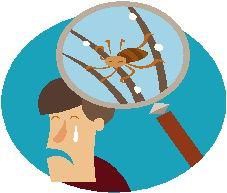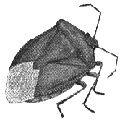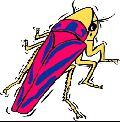Natural Solutions to Things That Bug You (72 page)
Read Natural Solutions to Things That Bug You Online
Authors: Myles Bader

Add 2 quarts of water mix well, strain and place into sprayer. Test an area first in case the mixture is too potent for plant leaves. Spray the area where the grubs have been found. Use only glass spray jars, never metal since metal may react with the chemicals in garlic.

HEAD LICE
General Information:
 This is a wingless blood, sucking parasite that is only about 1/10
This is a wingless blood, sucking parasite that is only about 1/10
of an inch long. It bites and will suck blood from the scalp of the person it gets attached to. It causes itching, swelling and lays eggs called “nits” on strands of hair. There are thousands of species worldwide in both the sucking and biting types. These bugs can only live for a few days when they are away from a human body. A female louse can lie about 8-10 eggs a day and only lives for a month.
Lice are able to take on the color of the hair that they infest. If you are a blond, the lice will be light-colored and if you are a brunette they will be darker.
A growing louse will keep feeding over and over every 2-3 hours and making a new puncture every time. This results in itching and discomfort. Its specialized anticoagulant saliva is what causes the itching and burning, which tends to force you to scratch your head. The scratching will then cause more bleeding and possibly and infection.
If you get a bad cold with a fever it will kill the lice since they cannot tolerate high temperatures. Adult lice and nymphs (baby lice). The adult head lice (louse), is no bigger than a sesame seed and is grayish-white or tan.
Nymphs are smaller and become adult lice about 1 to 2 weeks after they hatch. Most lice feed on blood several times a day, but they can only survive up to 2 days off the scalp.
With lice bites cause itching and scratching, which is actually due to a reaction to the saliva of lice. However, the itching may not always start right away and depends on how sensitive your child's skin is to the lice.
It can sometimes take days or weeks for kids with lice to start scratching. They may complain, though, of things moving around on or tickling their heads.
For some kids, the irritation is mild; for others it is a more bothersome rash. Excessive scratching can lead to a bacterial infection (the skin would become red and tender and may have crusting and oozing along with swollen lymph glands). Best to see your doctor and if your doctor thinks this is the case, he or she may treat the infection with an oral antibiotic.
You may be able to see the lice or nits by parting your child's hair into small sections and checking for lice and nits with a fine-tooth comb on the scalp, behind the ears and around the back of the neck. A magnifying glass and bright light may help. But it can be tough to find a nymph or adult louse — often, there aren't many of them and they're able to move fast.
SEE THE DOC OR PHARMACIST
If you feel that you have contracted lice it would be best to see your doctor of pharmacist for medication that will remove them safely. There are a number of shampoos and medications that work well.

KILL THE BUGGERS
Use a coconut-based shampoo specifically designed for head lice. Drug stores sell lice combs that will comb-out the nits. Shampoos with pyrethrums also work very well. Check with the pharmacist for any new treatments. Keep repeating the process daily until the lice and their nits are 100% gone.
LEAFHOPPER
Identification:
 These are slender wedge-shaped bugs that suck juices from the plants and kill the leaves as well as spreading viruses and bacteria to other plants. Some are green, while others are green with some red and white markings. They will fly off when disturbed and will usually be found on the underneath side of the leaf.
These are slender wedge-shaped bugs that suck juices from the plants and kill the leaves as well as spreading viruses and bacteria to other plants. Some are green, while others are green with some red and white markings. They will fly off when disturbed and will usually be found on the underneath side of the leaf.

General Information:
Leafhoppers tend to frequent apple trees, beet plants and potatoes. The dragonfly will eat them, when they can find them.
The most common leafhopper is the “aster,” which has six spots over a greenish-yellow area on its back, the beet leafhopper, the potato leafhopper and the red-banded leafhopper.
KILL THEM IN THE MORNINGS
The best method of killing them is to spray them early in the morning with an insecticidal soap solution. The leafhoppers are less active in the mornings. The only bug that seems to like these insects is the lacewing, which will eat their eggs. Of course, the lacewings will eat almost any insect eggs.
A GOLDEN CURE
Marigolds will eliminate the leafhoppers. Just crush 6 ounces of the leaves, roots and flowers then pour 4 cups of boiling water over it and allow it to soak for 24 hours. Add 4 more cups of cold water, strain and use as a spray.
THEY HATE PETUNIAS
If you plant petunias or geraniums in areas where you suspect trouble it will repel the bugs.
SPRAY THEM
Any liquid soap spray will eliminate the bugs in short order. Also Diatomaceous earth (DE) will also work great at keeping them at bay.
LEAFHOPPER (GRAPE)
General Information:
 Both the adults and nymphs feed on the underneath side of the leaves resulting in spots that will turn brown. If there is a bad infestation the fruit will be affected.
Both the adults and nymphs feed on the underneath side of the leaves resulting in spots that will turn brown. If there is a bad infestation the fruit will be affected.
LEAFHOPPERS KILLED BY WASPS
The grape leafhopper: can be controlled by releasing the parasitic wasp called
Anagrus epos
in the early part of the growing season. These wasps are capable of producing three generations in one summer.
During the early part of the summer the wasp prefers to feed on leafhoppers that frequent blackberries and it would be wise to plant some around the edges of the grape vineyard. When summer arrives the wasps will head for the vineyard and eat the grape leafhoppers.
ZAP, BLUE-LIGHT SPECIAL
A special blue-light insect electrocuting light trap is available that will make short work of these pests.
LEAFHOPPER (POTATO)
General Information:
In the southern states this bug is called the “bean jassid.” It is a small wedge-shaped green leafhopper with white spots on its head and thorax. The nymphs have an odd habit of crawling sideways like a crab.
The leafhopper causes a condition on the potato plants known as “hopperburn” in which the tips and sides of the potato leaf will curl upward, then turn yellow or brown and become brittle. They will lay their eggs in the main veins of the leaves.
CANOPIES WORK
Leafhoppers prefer open areas where they can easily move on if necessary. If you plant the potato plants in a sheltered area they will probably not come around. If this is not practical then you may need to protect the plants with a netting of cheesecloth, muslin or other type of netting material.
KILLS THE BUGS AND INCREASES GROWTH
A dusting of pyrethrum will eliminate the leafhoppers as well as act as
 a growth stimulant for the plants.
a growth stimulant for the plants.
